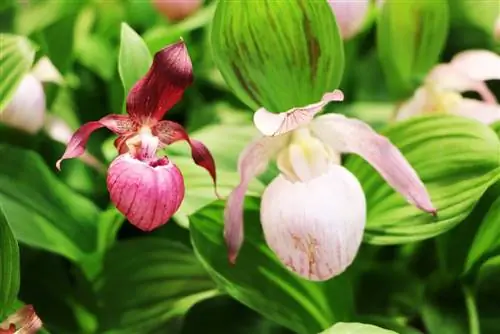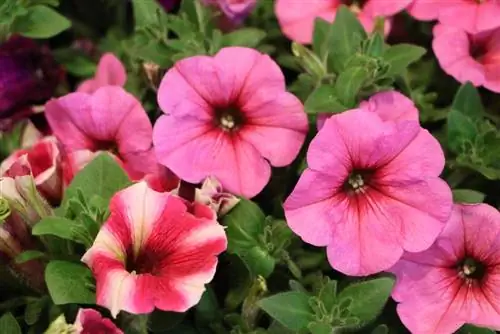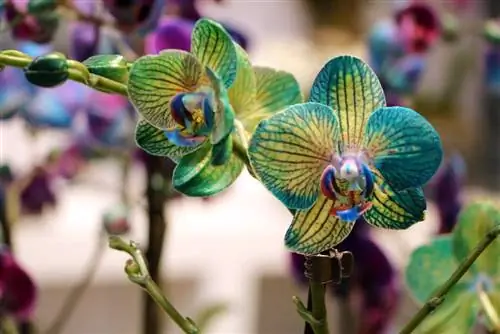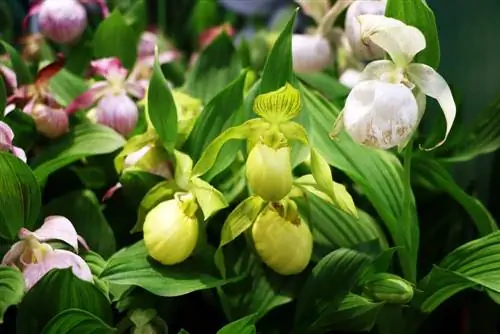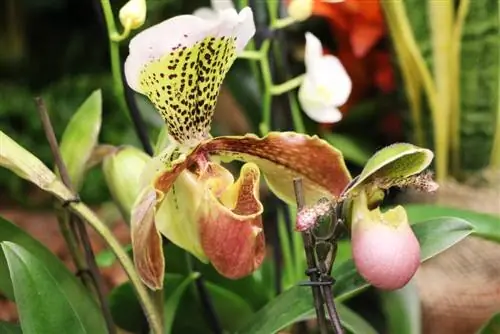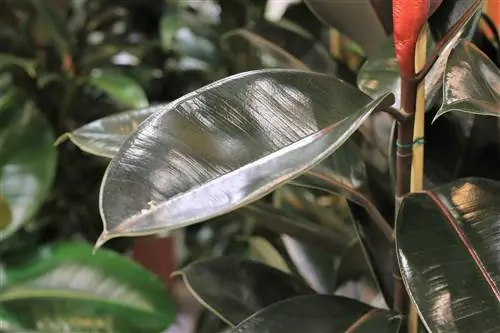- Author admin [email protected].
- Public 2023-12-17 03:39.
- Last modified 2025-01-24 12:45.
They are true gems and an ornament for every garden - outdoor orchids. So it's no wonder that they are now enjoying great popularity. However, some people shy away from these fascinating plants because they fear that they require a lot of work and require special knowledge. This fear is of course absolutely unfounded. On the contrary: outdoor orchids are extremely easy to care for - provided you follow a few basic rules.
Species
When we talk about outdoor orchids, it always refers to orchid species that are generally found wild in nature in this country. There are around 60 of them, after all. Anyone who dreams of cultivating a tropical orchid species in their garden is doomed to failure because the plant would not be able to cope with our climatic conditions. The situation is completely different with the domestic or northern European species. They are even hardy. However, you should be careful not to simply dig up wild orchids in nature and then plant them in the garden.
That would be at least an administrative offense, as the plants, which have now become very rare, are protected species. They must therefore not be dug up, cut off, picked or damaged in the wild. If you do, you risk a hefty fine. Outdoor orchids for your own garden must therefore be purchased from specialist retailers and should necessarily have proof of origin. This evidence proves that these are special breeds that are based on the orchid species that grow wild in our country, but have not been taken directly from nature. The following breeds are very popular:
- Cypripedium (lady's slipper)
- Dactylorhiza (Orchid)
- Epipactis (Stendelwort)
- Pleione (mountain orchids)
- Aceras anthropophorum (Ohnhorn)
- Bletilla striata (Japanese orchid)
- Orchis purpurea (purple orchid)
All of these types of orchids are so-called terrestrial orchids. So they are actually planted in soil and do not require any special substrate to thrive. The most popular and most widespread is certainly the lady's slipper.
Tip:
Fascinating species such as the Japanese orchid are usually very difficult to obtain from specialist retailers. If they are offered once, you should definitely secure several copies.
Location

In order for the cultivation of outdoor orchids in the garden to actually be successful, the most important thing is the right location. The choice of location is therefore the all-important aspect. It's best to think very carefully in advance about whether the necessary location characteristics can actually be met. This not only saves costs, but also often bitter disappointments. The right location for outdoor or ground orchids must meet the following criteria:
- it should be in partial shade
- it should only have moderate sun exposure
- it should not be exposed to the midday sun
- it should be protected from strong winds and rain
Note:
Some types of orchids such as Bletilla striata or Epipactis can tolerate a location in full sun if necessary, but you are definitely on the safe side with a partially shaded spot for them too.
Outdoor orchids are often cultivated in the garden in the company of so-called companion plants. Those that form a rather light tree are particularly ideal. However, it is important that the orchid still receives enough light despite the accompanying plants. The perfect location would be on the north side of such a light tree, because the orchid is then usually somewhat protected from heavy rain or even hail.
Floor
As already mentioned, outdoor orchids do not require a special substrate on which they can thrive. They are therefore simply planted in the existing garden soil. However, this does not mean that the orchid thrives equally well in every soil. Outdoor orchids generally prefer lime-rich soils, which should also have a high pH value. Orchids are therefore lime-loving. The pH value of a so-called neutral soil is 6.5. For orchids it should generally be above this.
Tip:
The pH value of a soil can be easily determined using so-called indicator sticks, which can be purchased from specialist retailers.
In order to increase the pH value for the orchid, it is recommended to add unfertilized garden lime to the soil at the planting location. It is also advisable to add limestone, as this can also achieve a longer-lasting effect. In addition, the soil should be extremely well permeable to water. Although orchids generally like it moist, they cannot tolerate waterlogging under any circumstances. This is usually not a problem with sandy soils. However, if the soil contains a lot of clay, plenty of coarse sand must be mixed in where the plant is located.
Note:
The soil for outdoor orchids must under no circumstances be enriched with compost, as this can very quickly lead to over-fertilization, which would definitely cause the plant to suffer.
Planting
Once the soil has been prepared accordingly and, above all, the lime content has been increased, it is time to plant the commercially purchased orchid. The ideal time for this is either spring (April to May) or early fall (September to October). When planting, the first thing to do is dig a pit about 40 centimeters deep. Then create an approximately 15 centimeter thick drainage made of gravel or very coarse expanded clay in the pit. To ensure an additional increase in the lime content, it is recommended to add limestone to the drainage.
The drainage is then followed by a layer of treated soil approximately 25 to 30 centimeters thick. The plant is ultimately placed in this soil. The shoot tips should be just covered with soil. However, the earth must not be pressed down, but must remain loose. Finally, there is a maximum two centimeter thick cover made of beech leaves or, better yet, fine expanded clay gravel.
Care
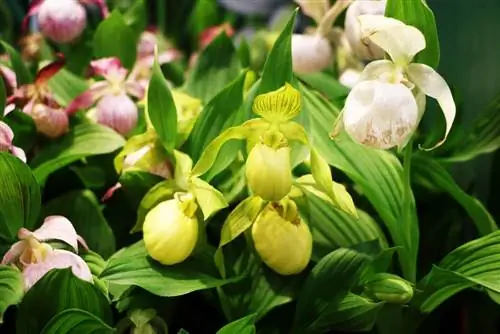
Even if people often claim otherwise - outdoor orchids are extremely undemanding and therefore relatively easy to care for. In any case, the effort required for care is limited. In principle, you just need to water regularly. The following applies:
- check the soil around the plant regularly
- make sure that the ground is always moist to slightly boggy
- use watering indicator if necessary
- water if necessary
- be sure to avoid waterlogging
- feel free to use hard water
Opinions have been divided for many years on the question of whether outdoor orchids need to be fertilized or not. Basically, it's better to fertilize too little than too much. Fertilization is not necessary in the first two years after planting. In the following years it is important to pay attention to how the plant develops. If it no longer wants to grow properly, add a little liquid fertilizer to the irrigation water. There are special fertilizers on the market that are tailored to the needs of outdoor orchids. Alternatively, fertilizers for indoor orchids and flowering plants can also be used. Then, however, you should limit yourself to a quarter of the specified amount.
Note:
Outdoor orchids do not need to be cut. They thrive even without pruning under the right conditions.
Wintering
Outdoor orchids from our latitudes are generally hardy. They therefore do not have to be overwintered and removed from the ground. The plants survive frosts without any problems, and some species can even withstand temperatures as low as minus 20 degrees Celsius. Other species, however, are a little more sensitive. To be on the safe side, the plants should be well covered with pine branches or leaves in the winter months. They may all be hardy, but a warm protective layer is still good for them. Of course, this also applies to snow, which will hopefully cover them well in winter.

